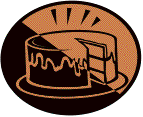|
Cake Origins
Cakes date back to ancient Egypt as round, flat, unleavened breads that were cooked on a hot stone. Their evolution from crude cakes to what we enjoy today was possible through the introduction of new ingredients and technology. The Egyptian's discovery and skill at using natural yeast, helped leaven those once flat cakes. When butter and eggs found their way into the cake dough, their consistency became the precursor for today's cakes. Cake making continued to improve especially with the new ingredients such as chocolate and vanilla, and sugar that came to Europe with the discovery of the New World.
By the 18th century cakes were being made without yeast. Some yeast risen cakes survived, such as the Alsatian Kugelhopf, but the new cakes got their lightness from beaten eggs. Not only did some recipes call for an astounding number of eggs (upwards of 30) but they required long hours of beating. Unfortunately this went on until technology caught up with the invention of baking soda (1840s) followed closely by baking powder (1860s). The quality of baked goods would continue to improve over time as ingredients became more refined and of a consistent quality.
 Many centuries would pass from the baking of a cake on a hot stone to baking in a hot electric/gas oven. One step along the way to the modern oven was the placement of an oven (box) inside the fireplace that sometimes had a door. Obviously it was quite an art to control the temperature and items were placed in the oven according to their baking times. Even the early replicas of modern ovens we have today did not have temperature controls. Some women as late as the early 1900s were still measuring an oven's temperature by sticking a piece of paper into the oven and waiting to see how long it took to brown. Or worse yet, they stuck their hand in the hot oven judging the temperature by how long they could leave their hand in the oven. Many centuries would pass from the baking of a cake on a hot stone to baking in a hot electric/gas oven. One step along the way to the modern oven was the placement of an oven (box) inside the fireplace that sometimes had a door. Obviously it was quite an art to control the temperature and items were placed in the oven according to their baking times. Even the early replicas of modern ovens we have today did not have temperature controls. Some women as late as the early 1900s were still measuring an oven's temperature by sticking a piece of paper into the oven and waiting to see how long it took to brown. Or worse yet, they stuck their hand in the hot oven judging the temperature by how long they could leave their hand in the oven.
The lines between bread and cake were once almost indistinguishable. The main difference was their shape and that cakes had a sweetener, usually honey. But over time their differences grew to the point where bread remains a staple food and cakes are now considered desserts.
---Stephanie Jaworski
Joy of Baking
* DVO welcomes your kitchen hints and cooking or nutrition questions! Email us and we'll post your hints and Q/A's in upcoming newsletters! *
|














 Many centuries would pass from the baking of a cake on a hot stone to baking in a hot electric/gas oven. One step along the way to the modern oven was the placement of an oven (box) inside the fireplace that sometimes had a door. Obviously it was quite an art to control the temperature and items were placed in the oven according to their baking times. Even the early replicas of modern ovens we have today did not have temperature controls. Some women as late as the early 1900s were still measuring an oven's temperature by sticking a piece of paper into the oven and waiting to see how long it took to brown. Or worse yet, they stuck their hand in the hot oven judging the temperature by how long they could leave their hand in the oven.
Many centuries would pass from the baking of a cake on a hot stone to baking in a hot electric/gas oven. One step along the way to the modern oven was the placement of an oven (box) inside the fireplace that sometimes had a door. Obviously it was quite an art to control the temperature and items were placed in the oven according to their baking times. Even the early replicas of modern ovens we have today did not have temperature controls. Some women as late as the early 1900s were still measuring an oven's temperature by sticking a piece of paper into the oven and waiting to see how long it took to brown. Or worse yet, they stuck their hand in the hot oven judging the temperature by how long they could leave their hand in the oven.